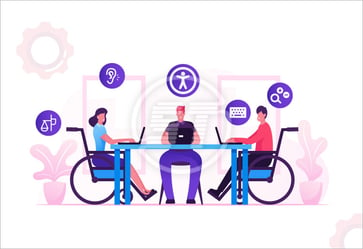The Human Rights Act was enacted in 1993 in New Zealand. The idea was to protect the rights of individuals with disabilities and provide them with accessible digital content from both public agencies and private entities. However, it was not meant specifically for websites back then, but it was a general framework for all products and services offered by different industries.
Later on, the New Zealand government felt the need for exclusive digital guidelines, and in 2001, the New Zealand Web Accessibility Standard (NZS 4121:2001) was published. These guidelines are mainly focused on accessible web designs and can be considered as the best web development practices.
If your organization operates in New Zealand, you must know how to incorporate accessibility in your digital products or services.
Some important requirements of the New Zealand Web Accessibility Standard (NZS 4121:2001)
- The standards apply to all public-service and non-public-service departments in the State services.
- All public-facing websites and internal administration websites must conform to WCAG 2.1 level AA requirements.
- Every organization is required to prepare an assessment report on conformance level and in case of non-conformance, they should submit a risk assessment and management plan (whenever asked by the Department of Internal Affairs). The report is also important to attract users because they come to know if website is usable or not.
- The WCAG requirements are subject to exception after careful consideration by the Department of Internal Affairs.
- Complex website map data ought to be published in an open, machine-readable format.
- Time-based media must have descriptive text transcripts.
- Live audio content in synchronized media and pre-recorded audio requires captions.
- Web products and services that are outsourced must be accessible.
- In September 2008, New Zealand ratified the United Nations (UN) Convention on the Rights of Persons with Disabilities. Thus, New Zealand needs to show digital accessibility improvements. Read more on this.
- Website compatibility with assistive technology is crucial.
- PDFs and other office documents ought to be accessible. All accessibility measurements must be taken carefully as per WCAG 2.1 success criteria.
- Semantic HTML markups should be used properly so browsers and assistive technologies can understand the content structure. The role and purpose of content with precise semantic markups can be programmatically determined and communicated clearly via assistive technology.
- If colors are used to convey meanings, their visibility is important or there should be an alternative to make colors understandable.
- Keyboard accessibility is essential to ensure seamless navigation and interaction with various web pages.
- Specify the language of the content written in, so that browsers and ATs can understand it.
- Abbreviations must accompany with their expanded form wherever they are used for the first time.
- Headings and sub-headings ought to adhere to logical hierarchy.
- Images on their own are unusable for many disabled users. Thus, all images on websites need alt text to explain their usage and context.
- Video content requires captions, audio descriptions, descriptive text transcript, and sign language translation. Also, auto-play shouldn’t be enabled.
Read the detailed document to understand accessibility requirements. A quick reference document for the web development team.
Benefits of accessible digital content
- The websites with accessibility implementation are easier to use for everyone.
- Accessibility enhances website reach. Government welfare programs and activities can reach to maximum New Zealanders.
- Accessible websites are easy to crawl for search engines.
- Most importantly, accessible websites safeguard organizations from being sued or encountering huge penalties for violating laws.
Wrapping up
All public-facing websites in New Zealand are expected to provide accessible content to all their citizens because it is their basic right. Thus, make sure to offer more usable and accessible content in order to reduce discrimination and provide equal opportunities to citizens with any sort of disabilities.
Ask your web development partners to include NZS 4121:2001 requirements to your existing websites or build a new accessible one from scratch.
Is your website, web application, documents, or mobile application compliance to accessibility standards like NZS 4121:2001, ADA, WCAG, Section 508, etc.? Whether it is or not, Skynet Technologies helps to make and improve website accessibility with comprehensive digital accessibility services. With a team of experts, we provide managed website accessibility services including audit, strategy, design, development, website remediation, document remediation, VPAT report, ongoing monitoring, and support. Reach out hello@skynettechnologies.com or request a quote.


